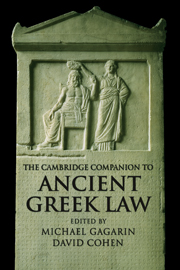Book contents
- Frontmatter
- Introduction
- Part 1: Law in Greece
- Part 2: Law in Athens I: Procedure
- Part 3: Law in Athens II: Substantive Law
- 11 Crime, Punishment, and the Rule of Law in Classical Athens
- 12 Gender, Sexuality, and Law
- 13 Family and Property Law
- 14 Athenian Citizenship Law
- 15 Commercial Law
- Part 4: Law outside Athens
- Part 5: Other Approaches to Greek Law
- Index
15 - Commercial Law
from Part 3: - Law in Athens II: Substantive Law
Published online by Cambridge University Press: 28 August 2006
- Frontmatter
- Introduction
- Part 1: Law in Greece
- Part 2: Law in Athens I: Procedure
- Part 3: Law in Athens II: Substantive Law
- 11 Crime, Punishment, and the Rule of Law in Classical Athens
- 12 Gender, Sexuality, and Law
- 13 Family and Property Law
- 14 Athenian Citizenship Law
- 15 Commercial Law
- Part 4: Law outside Athens
- Part 5: Other Approaches to Greek Law
- Index
Summary
A defining characteristic of classical Greek civilization is its tendency to understand and to organize phenomena not (as we do) through definitional focus on a specific subject in isolation, but through contrast, preferably through complementary antithesis. In no context, perhaps, is this trait more striking than in the area of commerce and commercial law. Although Anglo-American law easily contrasts “real property” and “personal property” but still allows for items sharing certain characteristics of both (“fixtures”), the Greek antithetical universe recognized only two contrasting divisions - “visible property” (phanera ousia) or “invisible property” (aphanēs ousia) - and even the differentiation between realty and personalty tended to be expressed through this distinction. Even the sale of sex was practiced through polarity: pragmatic business and conceptual legal distinctions flow from the binary contrast of the pornē (“whore”) and the hetaira (“courtesan”).
- Type
- Chapter
- Information
- The Cambridge Companion to Ancient Greek Law , pp. 290 - 302Publisher: Cambridge University PressPrint publication year: 2005
- 10
- Cited by

